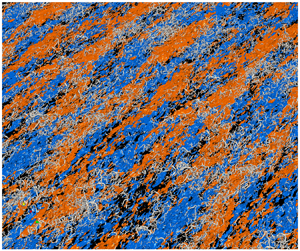Article contents
Large-scale characteristics of a stably stratified turbulent shear layer
Published online by Cambridge University Press: 28 September 2021
Abstract

Implicit large eddy simulation is performed to investigate large-scale characteristics of a temporally evolving, stably stratified turbulent shear layer arising from the Kelvin–Helmholtz instability. The shear layer at late time has two energy-containing length scales: the scale of the shear layer thickness, which characterizes large-scale motions (LSM) of the shear layer; and the larger streamwise scale of elongated large-scale structures (ELSS), which increases with time. The ELSS forms in the middle of the shear layer when the Richardson number is sufficiently large. The contribution of the ELSS to velocity and density variances becomes relatively important with time although the LSM dominate the momentum and density transport. The ELSS have a highly anisotropic Reynolds stress, to a degree similar to the near-wall region of turbulent boundary layers, while the Reynolds stress of the LSM is as anisotropic as in the outer region. Peaks in the spectral energy density associated with the ELSS emerge because of the slow decay of turbulence at very large scales. A forward interscale energy transfer from large to small scales occurs even at a small buoyancy Reynolds number. However, an inverse transfer also occurs for the energy of spanwise velocity. Negative production of streamwise velocity and density spectra, i.e. counter-gradient transport of momentum and density, is found at small scales. These behaviours are consistent with channel flows, indicating similar flow dynamics in the stratified shear layer and wall-bounded shear flows. The structure function exhibits a logarithmic law at large scales, implying a  $k^{-1}$ scaling of energy spectra.
$k^{-1}$ scaling of energy spectra.
JFM classification
- Type
- JFM Papers
- Information
- Copyright
- © The Author(s), 2021. Published by Cambridge University Press
References
REFERENCES
- 16
- Cited by



